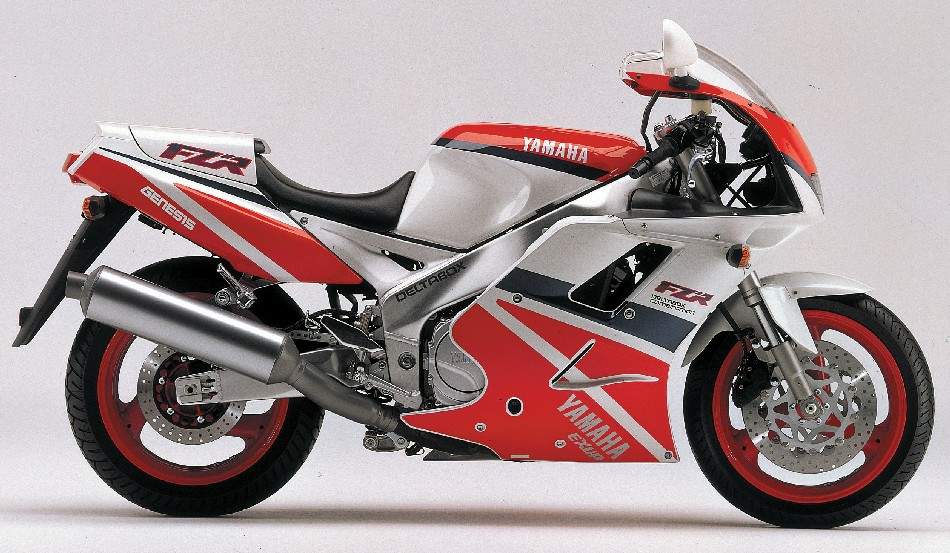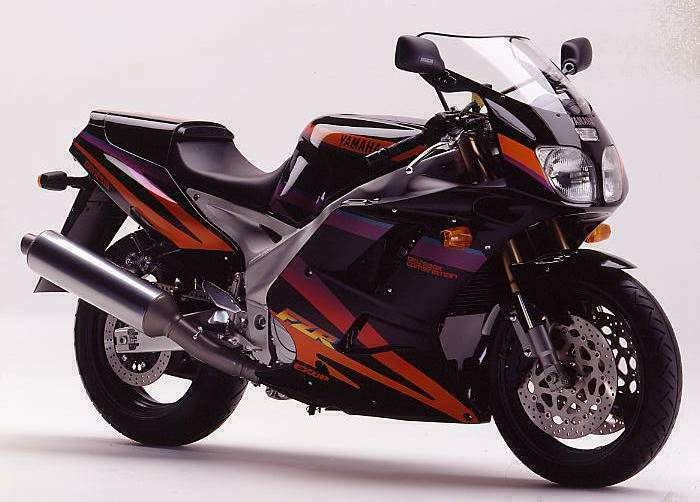
|
|
|
|
|
|
Classic Bikes
Custom Bikes
Individual
Racing Bikes AJP
AJS
Aprilia
Ariel
Avinton / Wakan
Bajaj
Benelli
Beta
Bimota
BMW
Brough Superior
BRP Cam-Am
BSA
Buell / EBR
Bultaco
Cagiva
Campagna
CCM
CF Moto
Combat Motors
Derbi
Deus
Ducati
Excelsior
GASGAS
Ghezzi Brian
Gilera
GIMA
Harley Davidson
Hero
Highland
Honda
Horex
Husaberg
Husqvarna
Hyosung
Indian
Jawa
Kawasaki
KTM
KYMCO
Laverda
Lazareth
Magni
Maico
Mash
Matchless
Mondial
Moto Guzzi
Moto Morini
MV Agusta
MZ / MuZ
NCR
Norton
NSU
Paton
Peugeot
Piaggio
Revival Cycles
Roland Sands
Royal Enfield
Sachs
Sherco
Sunbeam
Suzuki
SWM
SYM
Triumph
TVS
Ural
Velocette
Vespa
Victory
Vincent
VOR
Voxan
Vyrus
Walt Siegl
Walz
Wrenchmonkees
Wunderlich
XTR / Radical
Yamaha
Zero
Video
Technical
Complete Manufacturer List
|
Yamaha FZR 1000 EXUP |
| . |
|
Make Model |
Yamaha FZR 1000 EXUP |
|
Year |
1993 |
|
Engine |
Four stroke, 35° forward inclined transverse four cylinder, DOHC, 5 valves per cylinder |
|
Capacity |
1002 cc / 61.2 cu/in |
|
Bore x Stroke |
75.5 x 56 mm |
|
Compression Ratio |
Liquid cooled |
|
Cooling System |
12.0:1 |
| Compression Pressure | 14kg/cm2 (1400kPa, 199 psi) |
| Compression Range |
13.6kg/cm2 (1360kPa, 194psi) minimum 14.8kg/cm2 (1480kPa, 210psi) maximum |
| Lubrications | Wet sump |
|
Exhaust |
EXUP exhaust control system |
|
Induction |
4x 38mm Mikuni BDST |
|
Ignition |
TCI digital ignition |
| Battery | YB14L 12V 14AH |
|
Starting |
Electric |
|
Max Power |
145 hp / 105.7 kW @ 10000 rpm |
|
Max Power Rear Tyre |
131.7 hp @ 10500 rpm |
|
Max Torque |
10.9 kgf-m / 107 Nm @ 8500 rpm |
|
Clutch |
Wet, multi-disc |
|
Transmission |
5 Speed |
|
Final Drive |
Chain 532ZLV |
| Secondary Ratio | 68/41 (1.659) |
|
Frame |
Ddiamond Deltabox |
|
Front Suspension |
43mm Telehydraulic for adjustable preload |
|
Front Wheel Travel |
120 mm / 4.7 in |
|
Rear Suspension |
Gas/oil single shock, rising rate adjustable preload and damping. |
|
Rear Wheel Travel |
130 mm / 5.1 in |
|
Front Brakes |
2x 320mm discs 4 piston calipers |
|
Rear Brakes |
Single 267mm disc 1 piston caliper |
|
Front Tyre |
130/60 VR17 |
|
Rear Tyre |
170/60 VR17 |
|
Rake |
26.7° |
|
Trail |
110mm / 4.33 in |
|
Dimensions |
Width 730 mm / 28.7 in
Height 1160 mm / 45.7 in |
|
Wheelbase |
1460 mm / 57.5 in |
|
Seat Height |
765 mm / 30.1 in |
|
Ground Clearance |
135 mm / 5.3 in |
|
Dry Weight |
209l kg / 460 lbs |
|
Wet Weight |
236 kg / 520 lbs |
| Fuel Capacity | 19 Litres / 4.2 gal |
| Consumption Average | 16.3 km/lit |
| Braking 60 - 0 / 100 - 0 | 13.1 m / 37.0m |
| Standing ¼ Mile | 10.1 sec / 216.8 km/h |
| Top Speed | 273.4 km/h / 169.8 mph |

Yamaha's FZR1000
is a maximum sports bike in every sense and has be- o come something of an
industry standard. The machine has Y' won countless Bike of the Year awards
and has even been voted Best Bike of the Eighties. Its success can largely
be attributed to the fact that it does everything pretty well and n nothing
particularly badly. It has astonishing power yet the chassis can handle it
and deliver the performance through " the tyres to the road. More
significantly, it's comfortable and rider-friendly. Although undeniably a
pure sports machine, its abilities are not confined to the racetrack and
world-wide sales confirm its position as one of the very best road bikes
available.
Developed from the YZF factory endurance racer, the FZR1000 uses much of the
engine technology Yamaha first displayed on their pioneering FZ750 road
bike. Each of the four cylinders uses five valves - three inlet and two
exhaust - and the cylinder bank is inclined forward allowing the use of
downdraft carburettors and a short, dead straight inlet path for better
cylinder filling.
The result is a free-revving engine that will pull from idling speed to the redline making smooth linear power all the way. Performance is electrifying with instant response anywhere in the wide, flat torque curve and enough brute acceleration to spin the tyre at 90mph.
Performance already assured and restricted to 125hp in a number of markets (carb rubbers blank-off part of the inlet tract and many owners simply take a sharp blade to them), Yamaha unveiled a more powerful version in 1989, the FZR1000 Exup. This made 139hp in unrestricted guise and was equipped with hotter cams, lightweight valvegear and high compression, all in pursuit of more top end poke and speed. To compensate for the slight loss in low and mid-range power, Yamaha fitted an electronic, servo operated rotary valve in the exhaust (Exup). This varied the effective length of the exhaust pipe at different rpm and helped boost low and mid-range power levels.

At the same time, they eased the forward inclination of the cylinders from 45-degrees to 35-degrees, still keeping weight usefully low, forward and bearing on the front wheel but now also enabling them to shorten the wheelbase for faster steering response.
The FZR handles beautifully thanks to the rigidity of the very stiff, large section aluminium frame. Named Deltabox, the frame was developed from Yamaha's V-four 500cc GP racer and the near vertical position of the FZR's carbs lends itself to peripheral frame layout. Equipped with sturdy forks, well-damped rear suspension and enormous 320mm floating brake discs, the FZR1000 is an object lesson in mating a hugely powerful engine to a strong yet fairly light and fast-responding chassis.
The result is a bike that can be both mannered and monstrous. The flexible power means easy cruising or touring with huge steps in speed is just a flick of the wrist away. Either way, the rider gets a lot of feedback about what's happening on the road. Impressed with the bike's roadholding and stability, confidence increases, he knows
he has power available everywhere so gets on the gas harder for a more aggressive ride, pushing the tyres, the suspension and the Ground Clearance nearer their limit. None of this will faze the FZR.
The bike that brought Yamaha to the forefront of super bike design was launched in 1987 and it was called FZR1000. The 1987 version of the Yamaha FZR1000 had a top speed of over 250km/h and the 1989 version, crowned “The bike of the Decade”, could accelerate from 0-60 in less than 3 seconds and it also had a top speed of over 270km/h. With these features any bike would be very appreciated, so production continued.

Yamaha improved the performance of the bike, notably in 1989 when the engine was enlarged to 1002cc and added an electronically operated exhaust valve whose acronym led to the bike being universally known as the EXUP.
In spite of higher displacement its size was 8mm shorter and more compact, due to a revised inclination angle of the cylinders to 35 degrees. Valve angles and sizes had been changed, as well as the camshaft timing. Bigger carburetors helped boost performance and the crankshaft has been strengthened, alog with countless other modifications.
The system added useful mid range performance and the engine’s power was also increased to 145bhp.
The unique feature which gave the 1989 onward models their “EXUP” name was a servo motor driven exhaust valve. This allowed large bore exhaust reader pipes (for excellent gas flow at high engine speeds) coupled with the valve restricting flow at lower revs, to speed the gas through.
The chassis was also improved and the bike handled better, making the EXUP the pick of the Japanese Super bikes.
The 1989 frame (now called Delta box 2) used the engine as a stressed member. Gone were the down tubes, replaced by a sturdy fixation of the cylinder head with the frames upper box section. This layout was the foundation for the radical YZF-R1 chassis layout almost 10 years later.
But improving didn’t stop there. In 1991 the package was further improved with the FZR1000RU, featuring sharper and upside-down forks.
The last model improvements were in 1991 and 1994, until the FZR1000 was replaced by the YZF 1000 Thunder Ace in 1996.
For 1989, Yamaha redesigned their biggest sport bike from the tires up, and it felt different. The new bike felt smaller, lighter and lower, though radical improvements became apparent out on the road. The bike got it seat redesigned becoming wider and the ergonomics were repositioned, making it more comfortable.
The FZR1000 was considered by many to be the best 1000 available when it was introduced in 1987. There have been no major revisions to the FZR’s design with the exception of substituting a single headlight in 91 and 92 years and adding four-pot brake calipers after 89. The ram-air was modified in 91 and 92 models. In its last years of production, the FZR was redesigned to its initial 2 headlights design and it stood like that until it exited production, in 1996.
The bike’s power plant was a water-cooled, 989cc engine whose angled-forward cylinder layout and DOHC, 20-valve cylinder format that had been introduced on the FZ750 two years earlier. This engine developed 130 bhp at 10000 RPM but Yamaha increased the engine’s displacement in 1989 to a 1002cc, developing a 145 bhp at10000 RPM and it was named Yamaha FZR1000 EXUP. The EXUP system boosted performance and torque and it was first to be used on a 4 stroke engine. The Exhaust Ultimate Power valve is an exhaust control system still used on the YZF R1 in a refined form, which controls the exhaust gas flow depending on the engine’s revolutions.
|
Any corrections or more information on these motorcycles will be kindly appreciated. |